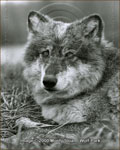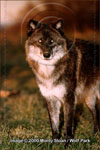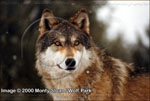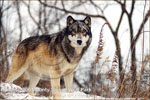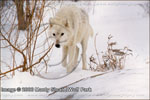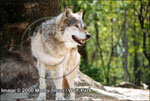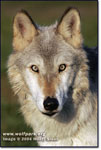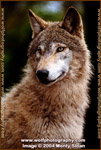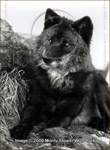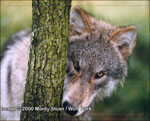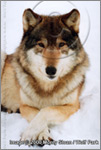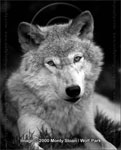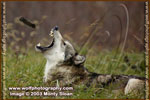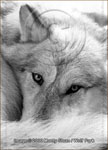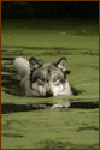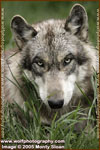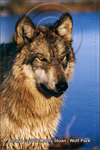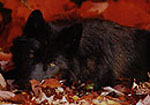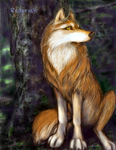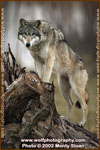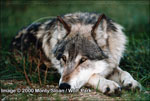Wolves of River Twine Holt
(Return to the River Twine Holt website.)
(article by Fey M., Holly H. & Whitney W. - first posted 04/10/07, updated 02/25/29)
(Note: images below are taken from Monty Sloan's Wolf Photography website, and are used with permission.)
The River Twine tribe's wolfpack is descended from wolves who came with Wolfsister when she led her group back to the area to settle. These wolves have at least some elf-blood in them, and although they are always primarily wolfish in outlook and behavior, the occasional "throwback" is born who is still wolf-shaped but who has a greater affinity for the elves than for the wolf-pack.
These partially elf-blooded wolves are more wolf than not, with the same appearance and behaviors as natural wolves. Their kinship and empathic bonds with the elves leads to a cooperative arrangement – but the wolves also tend to regard the elves as "odd" wolves. Elves are smaller and weaker, and have many strange un-wolflike behaviors. The wolves tolerate this and even respect and defer in some cases to the elves' behavioral choices; but in other cases the wolves simply treat the elves according to wolf norms.
Contents
- 1 APPEARANCE & CHARACTERISTICS
- 2 TERRITORIAL BEHAVIOR
- 3 BREEDING, PACK SIZE & MORTALITY
- 4 BONDING WITH ELVES & COMMUNICATION
- 5 RTH 2503 Wolf Pack
- 6 ALPHA PAIR
- 7 BETA WOLVES
- 8 HIGH RANKED WOVLES
- 9 MID-RANKED WOLVES
- 10 LOW-RANKED WOLVES
- 11 OMEGA WOLVES
- 12 PUPS
- 13 DECEASED MEMBERS OF THE PACK
- 14 IN-PLAY CONCERNS / HOW TO GO ABOUT REPLACING WOLF-FRIENDS
APPEARANCE & CHARACTERISTICS
The wolves of the River Twine pack are recognizable as grey wolves, and exhibit the usual range of pelt colors found in that species. Coat colors are limited to realistic wolf patterns and hues -- not pinto wolves, brindle wolves, etc. The RTH wolves are about a quarter-again larger and heavier than their natural (non-elf-blooded) cousins. They are also longer-lived, with a maximum lifespan of about 30 years (as opposed to 15 at most amongst natural wolves).
Throwback Wolves - Just as there are some rare elves with very lupine attributes, there have been the odd wolf with more elvish attributes. The only differences between them and the other wolves is that they are smaller in build, a little more sly/clever, and prefer elven company to the pack. They are always ranked as Omega, as they have little aspiration to earn rank among the pack, nor wish to devote the time to keeping it.
TERRITORIAL BEHAVIOR
The territory of the RTH pack is synonymous with what the elves consider to be the Holt's territory. Just as with natural wolf-packs, the RTH tribe/pack must defend its territorial boundaries from encroachment by neighboring natural wolf-packs. The Holt's territory is much larger than what a typical natural wolf-pack tends to claim, due to the fact that it must support not just the wolves, but also the elves.
The RTH pack tends on average to be three or four times the size of a natural wolf-pack, and in addition, there are usually as many elves as there are wolves. Because the RTH wolves are about a quarter-again larger/heavier than natural wolves, they require more food. For this reason, the RTH tribe/pack's territory has tended to be about 12,000-15,000 square miles in size, substantially bigger than natural pack territories. The cooperative nature of the elf-wolf bond is an advantage to the wolves in defending their large territory.
(For help in visualization: the territory is approximately the size of the state of Massachusetts. But, it features varied terrain, and a proportion of its raw square mileage is actually inaccessible and game-poor rocky mountaintops.)
The flip-side of this is that natural wolf-packs encountered outside of the Holt territory will regard elves as "odd" wolves from a rival pack (since this is, in effect, what they are). Even though the elves have wolf-blood, which even natural wolves may recognize, it won't necessarily "help" them if they encounter strange wolves, because even if they're recognized as "quasi-wolf", they'd also be regarded as "stranger/rival", and treated accordingly.
BREEDING, PACK SIZE & MORTALITY
There is a main denning area dug into a high knoll a few good bow-shots from the elves' dentrees. It has a wide entrance that dips down to connect with the chamber. There are a few small chambers to the side, with two smaller exits. When the Alpha female is preparing to birth a litter she'll often create a seasonal den a short distance from the main denning area.
The Alpha female is the only female in the pack who breeds, and she breeds only with the Alpha male. Because the RTH wolves have a longer lifespan than their natural cousins, and because they have more help with survival (in the form of the elves), their breeding rate overall is lower than amongst natural wolves.
Litters consist of 2-4 cubs. Only half of the cubs born to the wolf-pack tend to stay with the pack long-term. Those that bond to elves, of course, are the long-term members of the pack. Cubs that do not bond to elves have a 50% chance of surviving to the age of 3-5.
Those that reach yearling age un-bonded will tend to stay with the pack for 1-5 more years, on average. Some (usually naturally lower-ranked ones) disperse immediately, leaving the Holt territory to find a new pack, but all unbonded wolves will disperse if they still remain unbonded by about age 5 (with the exception of throwback wolves; but it is very rare that a throwback wolf does not bond with an elf).
Dispersing wolves may join neighboring natural packs, if there is room, or they may disperse quite far from the area to find a pack to join; but there is also a high rate of mortality amongst the dispersing wolves (not that the RTH tribe knows much about this). On occasion, some have managed to become breeders in neighboring wolf-packs, but not in any significant numbers; while generally bigger and stronger than any natural wolf, the elf-taint to the blood of an RTH wolf tends to make other packs less willing to accept dispersed RTH wolves into their ranks.
At any given time, the RTH wolf-pack consists mainly of wolves bonded to the tribe's elves, with about 6-10 unbonded wolves of various ages sticking around prior to death or dispersal.
BONDING WITH ELVES & COMMUNICATION
Most elves tend to bond with wolf cubs, by preference, and this means waiting for the alphas in the pack to have a litter. Elf children will almost always bond to a cub. But it sometimes happens that an elf in immediate need of a new wolf-friend will form an attachment with a yearling, or one of the unbonded wolves hanging around with the pack prior to dispersal. This may appeal more to active hunters, who do not wish to wait through several seasons to bond to a new wolf-friend and for that cub to grow up; but it also depends highly on the personal dynamics between the elf and the wolves.
Elves who specialize in hunting tend to bond to High or Mid-High ranked wolves, while trappers, fishers, and crafters tend to bond to the lower ranks; but there are sometimes exceptions to this. Elf rank status does not always guarantee bonding to a wolf of like status every time – especially since a wolf's exact pack status will change over time. (That is – the tribe's chief will not always be bonded to one of the pack Alphas; but, the tendency will be for the chief to bond to a wolf with high rank potential, and his or her wolf will often achieve Beta or Alpha status eventually, though not always.)
The wolves do not entirely understand or acknowledge elvish social structure, and they tend to treat a bonded elf as an extension of the wolf-bond's rank. If an elf is bonded to a high ranking wolf they are accorded some respect (able to ride the lower-ranked, for example); while an elf bonded to a low-ranked wolf might find the high-ranked wolves snapping at them for approaching downed prey, etc. This interesting ranking can result in amusing moments when a high ranking wolf feels the need to 'remind' a lower-ranked wolf's bond of 'their place'. There have been stories of the chief getting nipped in reproach after a hunt, since over the course of an elf's life, even a high-ranking elf such as the chief will not always be bonded to one of the alpha wolves. (Elf cubs are exempt from this, as all pups are. While the wolves regard elf childrens' slower maturing rate as "strange", by and large they tend to grant them the normal behavioral leniency accorded to all young, until the elf reaches the late-teens age of sexual maturity/exploration. This is usually taken by the wolves as a sign of adult status, and they will begin to treat the young elves accordingly.)
When a high-status elf loses a high-status wolf-friend, though, the elf is not automatically demoted to lowest status. The wolves do acknowledge elf-status on at least a basic level, in part because of the behavioral cues they pick up from their own elf-friends. Thus, the elf chief will probably always be treated as a high or mid-ranked wolf, even when bonded to a pup. However – wolves will never issue status-challenges to elves, or vice-versa.
Older wolves whose elf-friends die will almost always stay with the RTH pack, instead of dispersing. While there are some circumstances in which a wolf will perish with its elf-bond, it is not uncommon for a wolf to survive the death of its elf (through disease or freak mishap), just as elves may lose their wolf-friends but not perish themselves. However, it is rare for an older wolf to form a bond with another elf. High-ranking wolves in this situation will retain their pack-rank even after the death of an elf-friend. (The alphas would not stop being the pack's alphas, if they are still strong and healthy.)
Elf children bond to their first wolf-friends at age 7-9 on average; thus, first bonding as early as age 5 or as late as age 12 is not unknown.
Elvish wisdom tends to state that bonding with a wolf-cub forms the strongest emotional attachment between elf and wolf. This is not to say that an elf bonding with a yearling or older wolf will not form a strong attachment; just not **as** strong as the one formed with a cub, and there will be a bit more independence in the relationship. However, the strength of attachment also depends on other factors – the strength of the individual elf's wolf-bonding magic, as well (in some cases) as the bonding strength on the wolf's side.
Only in very rare circumstances will an elf bond with a wolf that does not come from the RTH pack. When this happens with a wolf from one of the neighboring natural packs (if, for example, an elf loses his or her wolf while outside of the Holt's territory on a long hunt), it is probably because there is a thread of elf-blood running through that pack as a result of a dispersing wolf from the RTH pack having successfully joined a natural pack and become a breeder. The integration of an "outsider" wolf-friend with the RTH pack can be very difficult, and most elves would avoid this option if at all possible.
All elves are capable of bonding with a wolf-friend, and all of them do so, no matter what the elf's tribal status. Some elves may go for periods of time (up to several years) without a wolf-friend, depending on circumstances, and whether they are waiting for the "right" wolf to be born.
One of the significant points of difference between elf culture and wolf behavior is that wolves will not continue to support weak or crippled members of the pack. Such wolves are demoted in status, and if not driven off, are subject to high mortality rates. Elves, on the other hand, will continue to support weaker or crippled tribe-members, allowing them to find a way to contribute to the tribe's life according to their abilities. Even these elves will bond to a wolf-friend (usually a very low-ranked one), and although this is another elvish behavior that the wolves consider "weird", they will accept the presence of "imperfect" tribe-members.
While the RTH wolves do have a sense of self, by and large they do not "name" themselves to each other in words. Most often, elves bestow names on their wolf-friends, especially in the case of wolf-cubs. Elves who bond to older wolves may choose a name for the wolf based on strong self-concepts that the wolf communicates through wolf-sending. Just as with elves, wolf-friend names can change over time, if something happens that ought to be commemorated with a new name (such as a notable event or deed; or a change in the wolf's appearance).
The elves will also give informal nicknames to the unbonded wolf-cubs who stay with the pack. These nicknames tend to be simpler and less creative than those given to wolf-friends, simply because the elves do not know the unbonded wolves as intimately as they do the bonded members of the pack. But, because an unbonded wolf may stay with the wolf-pack for up to 5 years, elves do give them nicknames that help distinguish them as individuals. (These nicknames are frequently based on obvious physical attributes, or on distinctive behavior.)
The elf-blooded wolves of the RTH pack can communicate with the elves through a simplified form of sending called wolf-sending. All the RTH pack's wolves are capable of this, and all elves except notably weak senders should be capable of receiving and sending with their wolves. Wolf-sending language is simple and direct; it consists largely of imagery and emotional/sensual impressions; when language is actually used, it is only rudimentary. It does not tend to contain complex concepts or structure. The sending range is also more limited than that of sending between elves; generally, to when the elf and wolf are in very close proximity. (Long-distance communication between elf and wolf, as between wolf and wolf, is accomplished through howling, which can be expressive and contain a surprising amount of information.)
In canon, a wolf-send was that between Nightrunner and Cutter in "Fire & Flight": **Humans. They bring fire.** An example of wolf-sending communication from a recent story in RTH is included below.
(from "Crackbone", by Whitney Ware)
**I need a wolf friend,** she repeated. She sent that to the young wolf, as firm and delicious an offering as she could think of. Wolves didn't send in words, and so neither did she now, casting to him only rich images of herself on his back and the two of them running, running, running under the light of two full moons, her carrying a huntress's weapons and him being followed by other wolves.
The big wolf was in front of her now. His tail was high, his shoulders and ears up, nothing remotely submissive in his stance. There was no escape from him now, Whistle knew. If the big wolf wanted her throat between his teeth, she could not stop him. His yellow eyes stared into hers, expecting her to break that gaze first as he smelled her over curiously. Whistle held her ground and held his stare, offering him again the promise of **us-together** and **hunting as two** and **racing in front of the pack, free and first** with all of the desire of her own young heart.
The big wolf whuffed once, his breath rancid. Then he sniffed imperiously at the wrapped leather bundle she carried, his gaze breaking from hers and locking instead on what she held. Whistle grinned in triumph and pulled the thigh-bone from the patch-rag scraps she had wrapped it in. The deer bone was clotted with blood and still had chunks of meat clinging to it. The big wolf took the bone from her eagerly and settled down to enjoy it.
**us-together** she sent to him, squatting to watch as he began to gnaw on her offering.
The big wolf met her eyes again as his powerful jaws cracked the bone into two. **running before the pack, free and first** was the image the wolf visioned back to her, self-satisfied and content. **Goldhair and Crackbone, together and showing only tails to the rest of the pack.**
RTH 2503 Wolf Pack
(photos used by permission of Monty Sloan/Wolf Park.)
The individual rankings of wolves within the pack is something that is in regular flux. A high ranking wolf will always lord it over a mid- or low-ranking wolf, but among high, mid, and low ranked wolves, it is often difficult for even the elves to tell what a linear hierarchy might be from day to day or week to week. What’s more important to understand are the roles played within the pack. The River Twine wolf pack usually numbers between 30 and 40 wolves at a time -- so not all of them will play the role of primary hunters. Some wolves perform more of a “guardian” role by ranging the territory, and the lowest play a “home guard/babysitter” role as the primary guardians of the Holt proper.
It is important for club members to understand that a wolf’s role within the pack does not always match their rider’s role within the tribe. Wolves do not exist at a rider’s beck and call. A wolf who is high-ranked, but who’s rider is not primarily a hunter, will generally be away hunting while his/her elf friend is back at the Holt fishing or crafting. Likewise, some of our tribe’s primary elven hunters can find themselves bonded with low-ranking wolves who are only grudgingly tolerated by their high ranked packmates. Elves who are bonded to mid-ranked wolves may find their wolf-friends off for days at a time, patrolling the woods and borders of the Holt’s territory with other mid-ranked wolves.
ALPHA PAIR
The Alphas are the leading male and female of the pack. The Alphas are the only breeding pair in the pack. The current Alpha wolves of the pack are:
BETA WOLVES
Beta wolves are the top ranked wolves within the Pack beneath the Alphas. These are individual wolves who are the likely heirs to the Alphas (but until the dust settles, don’t place your bets!)
Note: beta-ranked wolves listed in alphabetical order, not by hierarchal ranking
HIGH RANKED WOVLES
The high-ranked wolves are the primary hunters of the pack. They run at the front of the pack; after the Alphas and Betas they pick the choicest parts of a kill, and they are the most likely to become Alpha (after a previous Alpha's death, or through challenge). High ranked wolves are generally the most mature and intelligent hunters. Young wolves usually have some learning to do and must spend some time to spend in lower ranking positions before joining the high ranked hunters.
Note: high-ranked wolves listed in alphabetical order, not by hierarchal ranking
MID-RANKED WOLVES
While they sometimes join the hunt, wolves of the middle rank tend to be guards of the territory. They also enjoy the company of gatherers, trappers and those that scout. To them it shows the tribe contributing to the protection of the territories (and the elves have protection while doing their duties).
Note: mid-ranked wolves listed in alphabetical order, not by hierarchal ranking.
LOW-RANKED WOLVES
Low ranked wolves are the guardians of the denning area and protectors of any young pups. These are the wolves who are the daily guardians of the Holt proper.
OMEGA WOLVES
The omega wolves are the lowest-ranked of the low. They are often the babysitters and are the ones who teach the pups skills and social behaviors. Because they are lowest ranked they eat last (or not at all during lean times) and have no rights. Since they rely on the goodwill of the pack, they also tend to initiate playing.
PUPS
Roly-poly pups are generally considered rankless, but after their first winter, they are considered yearlings – and begin to risk being chased out of the pack. Yearlings who fail to bond to an elf-friend by the beginning of their second winter seldom remain with the pack. Unless they prove unusually clever or remarkably good as a hunter, these young wolves are driven out of the Holt by their elders, and the ones who are the most ambitious leave on their own to carve their own way in the world, outside of the Holt’s territory.
PUPS:
- 2501 Pup F (injured & killed during the winter of RTH 2002)
- 2501 Pup M (chased off during the winter of RTH 2003)
- 2501 Pup M (died soon after after birth, before its eyes opened)
- 2502 Pup F Redbrush -- (bond pending)
- 2502 Pup F Rooter -- (Bonded to Beetle)
- 2503 Pup M
- 2503 Pup F
- 2503 Pup M
DECEASED MEMBERS OF THE PACK
The following are some of our recently deceased members of the wolf pack:
IN-PLAY CONCERNS / HOW TO GO ABOUT REPLACING WOLF-FRIENDS
(this section is repeated in the Membership FAQ portion of the Wiki)
Although the wolves of the River Twine pack are significantly more long-lived than their natural cousins, they do have a lifespan of 25 to 30 years. Life for wolves is a dangerous thing, and wolves can die at any age from injury, starvation or illness. Most elves can expect to have *at least* four wolf-friends each century. In-play, this means that it won’t be unusual for characters to lose wolf-friends, and then have to forge new bonds.
The passing of a wolf-friend is an event due some respect, as is the experience of a new bonding. (And we hope you’ll memorialize both the loss and the new bond for your elf with fic or art!) Members who own characters with elderly wolves may also find themselves asked by the Council to have an old wolf pass on, in order to keep some balance in the pack.
To select a new wolf-friend for your elf, you have three choices:
a) select one of the currently available pups (pups are available on a first-come/first-serve basis)
b) select one of the available unbonded adult wolves described in the article above (note – when considering the adult wolf of your choice, consider why the mature wolf would be attracted to your elf as a bond-friend – many of these mature wolves are personalities in their own right, and a bond relationship is a two-way street!)
c) if there are no currently available pups, and none of the existing unbonded adults appeal to you, then put your name on a waiting list for the pick of next year’s litter!
Mature wolves will have some limited personality & physical description already determined for them, but members are free to create the personalities and descriptions for new pups, within the following guidelines:
- Pups can be bonded with at any point once they’ve physically begun to be weaned by the alpha female of the pack (pups are approximately six weeks of age at this point). Breeding season for the alpha male & female is normally late in the first month of the year; pups are born approximately 63 days later, early in the fourth month; pups would then be beginning to be weaned in mid-month of the fifth month. Additionally, wolves take at least a year to become full-grown; elf children might sneak rides on their wolf-bonds before a wolf is a full year of age, but this is frowned on, as it can cause damage to a wolf’s joints, causing future disability.
- We expect wolves to be “normal” looking: natural grey-wolf coloring is preferred with its natural range of color phasing allowed. Some allowance made for EQ-comics-style coloring (i.e. more solid coat colors). Please no wacky coloring/patterns. Albino wolves are extremely rare (no more than one at a time in the pack) and will be expected to have associated health issues: bonded albinos will always be omegas within the pack, and unless bonded as pups will be chased out of the pack at an early age.
- Wolves don't have the same range of eye colors as the elves. Eyes will be in a yellow/amber range, except for albino blue or pink. (While cubs, wolf eye colors will sometimes go through subtle color variations while the eyes change from the baby blue-grey color to adult gold.)
- You can submit drawn or painted artwork to represent your wolf. Otherwise, wolf photo portraits will be used to represent each wolf-friend. Please choose a snapshot from Monty Sloan's site (we have his permission to use his photos on our website as representational of our fictional pack). Please don't submit reference photos or art from anywhere else, without written permission of the photographer or artist. (If you have another reference pic you prefer, talk to one of our artists about creating a piece of art from it.)
- Throwback wolves are very rare, and will be limited to only two in-play within the pack at any time. (Our current throwbacks are Moss’s Weasel and Beetle’s Rooter.)
If at any time you intend to replace your character’s wolf-friend with a new one, email your wishes to the Council. (Understand that we do hope you’ll be creating fic or art to represent this important time of passage in your character’s life!) Additionally, every year in-play, the Council will look at the existing wolf pack and, taking into account the individual ages and temperaments of pack members, will shift the hierarchy accordingly. If you have any particular wishes for your character’s wolf-friend in term of increasing or deceasing their pack rank, please communicate this with the Council!
Additionally: once you determine you will replace an existing wolf-friend with a new one, you are asked to update your elf's CIS form with relevant information ASAP; please keep information regarding the old wolf under the "additional wolves" section of the CIS, for continuity purposes. We would also recommend posting a note to the message board regarding the new wolf friend, alerting other artists and authors to the date of the planned change.
(Return to the River Twine Holt website.)
